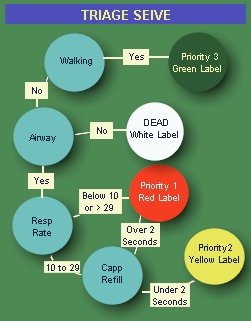Trauma Management
The priorities in trauma management are to prevent further injury, provide rapid transport, notify the receiving hospital, and initiate definitive treatment. Trauma patients can not be treated completely in the field. On scene time should be as short as possible unless there are extenuating circumstances, such as extrication, hazardous conditions, or multiple patients. Think about how the patient should be transported as soon as possible so that activation of a other means of transport, such as an air ambulance, if appropriate, can be performed in a good time. Notification of the receiving hospital of patient condition and status (ASHICE) should be done as early as possible. This gives the receiving hospital time to call a trauma team.
While enroute to scene consider mobilising a paramedic or even a BASICS doctor via your control room to assist with pain management and other invasive procedures i.e.. fluid infusion to replace lost blood volume. If the services of the doctor/paramedic are not required they can be stood down but it is good to get them running.
Mechanism of Injury
Definition: The way in which traumatic injuries occur; the forces that act on the body to cause damage.
Example: RTC
- Vehicle hits another object, e.g. wall. Or another vehicle.
- Occupants continue to move at speed of the vehicle, until they hit a stationary object, e.g. steering wheel, vehicle interior or seat belt.
- Their internal organs continue to move until they collide.
Trauma and Referred Pain
The presumption that pain originates at the site of that pain is often an incorrect one. Many times a painful area of the body is not the reason for that pain.
For example, a driver of a car is involved in an impact into a stationary object, i.e. a tree. On arrival at the scene the driver is out of the car and says he's ok apart from left shoulder pain. As an inexperienced technician you may think he's 'banged and bruised his shoulder'. After further questioning you find he's struck the steering wheel with his torso. This minor bit of information may seem irrelevant to you, but to the trauma team in A&E this is a critical bit of information. Why?
A. Left shoulder tip pain can indicate damage to the spleen
Referred pain is common, the reason being is that an area such as the diaphragm comes from an area of the spinal cord which also serves the area of skin over the shoulder. The conjoined nerves then give rise to pain not directly at the point of injury but a little distance from it, thus described as referred pain. As a technician you should be aware of this as it can reduce the risk of making an incorrect diagnosis.
Other examples of referred pain, but not necessarily trauma related are:
- The gall bladder referring pain on the top of the right shoulder.
- A diaphragm problem may be felt in the shoulder and neck
- Stomach problems may refer to the spine between the shoulder blades.
- Kidney pain may be felt in the groin area.
- A problem in the throat may be referred to the ear
Revised Trauma Score
The Revised Trauma Score is a physiological scoring system, with high inter-rater reliability and demonstrated accuracy in predicting death. It is scored from the first set of data obtained on the patient, and consists of Glasgow Coma Scale, Systolic Blood Pressure and Respiratory Rate.
(Champion HR et al, "A Revision of the Trauma Score", J Trauma 29:623-629,1989)
|
Glasgow Coma Scale (GCS) |
Systolic Blood Pressure (SBP) |
Respiratory Rate (RR) |
Coded Value |
| 13-15 | >89 | 10-29 | 4 |
| 9-12 | 76-89 | >29 | 3 |
| 6-8 | 50-75 | 6-9 | 2 |
| 4-5 | 1-49 | 1-5 | 1 |
| 3 | 0 | 0 | 0 |
Glasgow Coma Score
The scale categorises the patients responses to certain stimuli and gives that response a score. It is divided into 3 main categories of response.
A GCS of 8 or less indicates severe injury, one of 9-12 moderate injury, and a GCS score of 13-15 is obtained when the injury is minor.
Best Motor
Response
6 Obeys Commands
5 Localises pain.
4 Withdrawal to pain
3 Flexion
2 Extension
1 No response to pain.
Best Verbal Response
5 Oriented
4 Confused conversation
3 Inappropriate words
2 Incomprehensible sounds
1 No verbal response.
Eye Opening
4 Spontaneous.
3 Open to speech
2 Open to pain.
1 No eye opening.
Scene Management
- The management of a trauma scene should be performed under the direction of one person. That person should be an individual who is the most senior and been properly trained in the assessment and management of trauma patients, e.g. a BASICS doctor. Although you might have to assume the role until someone more senior arrives.
- Wear the appropriate Personal Protective Equipment (PPE) according to the incident. e.g. Hi Visibility jackets, Hard Hats, Gloves, in the case of an Road Traffic Crash (RTC)
- Ensure scene safety. First priority should be given to the safety of yourselves and then to altering the scene to make it a safe working environment or, if necessary, to moving the patient from the scene.
- Perform a scene survey to assess environmental conditions and mechanism of injury.
- Where more than 1 patient is involved then a TRIAGE will need to be under taken to evaluate treatment priorities.

-
Do you need the assistance of other emergency services? If so contact your control and request for the service needed.
-
If safe to do so. Approach patients in the order prioritised during TRIAGE. Carry out your primary, secondary and subsequent treatment of your patient (s).
ASHICE (Consider)
Transport to Hospital
Professional Handover
Further Reading
- Trauma Guidelines. (American. But good reading, PDF format)